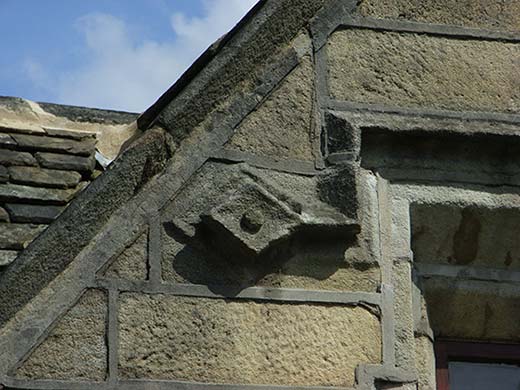History Society Report
Damn Your Eyes! Protection against the evil eye in human society and local architectur e
Speaker: John Billingsley
Monday, 19 February 2018
The magnificent 'Halifax houses' – the farm and clothiers' houses built or rebuilt of stone in 17th Century Calder Valley – often have decorative architectural details resembling the 'evil eye', commonly believed to ward off bad luck. But as John Billingsley, local folklore historian, told Hebden Bridge Local History Society, such symbols may be a sign of the growing wealth disparity of the age rather than the exercise of witchcraft.

There is certainly a strong resemblance between marks found across the Mediterranean and those decorations carved in stone above thresholds, such as a diamond surrounding a circle, representing the evil eye. Other decorative details found include arrows, crosses, spirals and pentagrams, all of which are thought to have protective qualities. From the myth of Medusa to modern day phrases such as 'withering looks' and 'looking daggers' there is a consciousness of the power of the gaze to do harm.
John believes that these conspicous symbols were there to deflect that envious gaze. The rich men in their extravagant houses were aware of the gap between rich and poor, and conscious too that if they had more, others had less. They wanted their houses full of 17th century extravagance, but also knew that boasting and glorying in their wealth was dangerous – envious looks could spell disaster.
So why did these symbols appear at this particular time and place in the architecture of the well to do? John links it with the change from a Medieval to a Renaissance world view, with a sense of communality giving way to the individualism which grew into modern capitalism. The houses themselves now had more private spaces such as parlours, away from the large hall that had been a semi-communal space. Prosperity was interpreted as a sign of God's favour but the needs of the poor were to be met by the poor law taxes rather than personal charity. At the same time there persisted a sense of fairness, a sense that a more equal society was a more balanced society. Perhaps, John argued, the wealthy felt the resentment of those who were poor and consequently a sense of unease that led them to protect themselves by symbols that acted as distractions.
We look at those carved decorations now as charming additions to the fine stone buildings, but perhaps, as John Billingsley argues, they represent the experience of profound social changes set in stone.
At the next meeting of the Hebden Bridge Local History Society at 7.30 on Wednesday 28th February at Hebden Bridge Methodist Church, Nick Wilding will look at 'Seven centuries of recorded floods in the Calder Valley', exploring what we can learn from history. All welcome.
With thanks to Sheila Graham for this report
Details of all the Society’s activities can be found on the website and you can also follow them on their Facebook page.
See also


